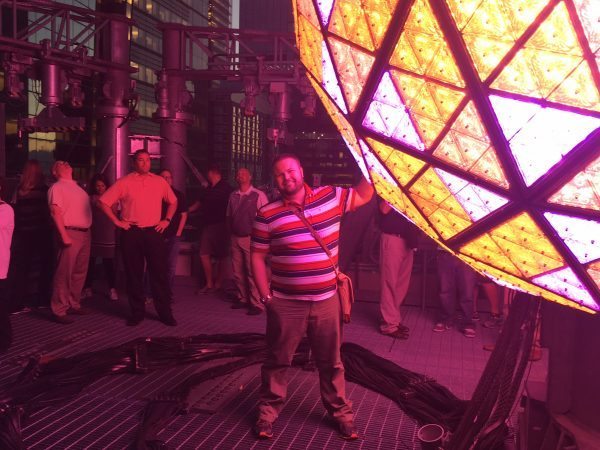In June, I had the privilege of seeing the New Year’s ball on the roof of One Times Square and meeting with the team of people who make the ball drop event possible every year. Still to this day, I am amazed at how the precise choreography, intricate components and all of the moving parts come together for sixty seconds every year flawlessly, regardless of external variables. In many ways, I think the ball symbolizes how the lighting business unfolded in 2016 and the reasons we should be optimistic about what 2017 will bring.
First, perception has a way of becoming reality. On TV, the ball appears to shimmer, but in person, I can attest that it does not. The reason it looks like it shimmers is because it is pulsing at a frequency cameras can detect but the human eye cannot. Similarly this year, the American Medical Association published a position statement on the effects of short-wavelength (blue) spectrum LED lighting in the outdoor environment which received a lot of attention from the press. This created a reasonable perception among consumers that some kind of a landmark discovery had been made against LED technology. However, those of us in the lighting industry who have been studying the human impact of lighting for years knew the evidence for such a conclusion was incomplete at best. Nevertheless, perception is a strong motivator and many hours of research were invested to evaluate the study’s claims. The end result? A lot of good dialogue and a renewed interest in the numerous benefits of a properly-executed LED lighting design.
Second, the ball is comprised of 672 triangular crystal modules that interlock together and connect to a central controller via miles of computer cables with numerous different types of connectors, plugs and hubs. In many ways, it reminds me of the lighting industry’s journey toward the Internet of Things (IoT), which was an overarching theme at Light Fair 2016 in San Diego. Just like the components of the ball, how do we get the controllers, fixtures and sensors to work in perfect concert to gather and react to data, give the user maximum controllability and reduce electrical demand? The future of the lighting industry is seamless integration of controls and 2016 was a pivotal year for testing the market with new technology and ideas. Much like the ball, however, we still need a few jumper cables here and there to get it just right.
Third, the ball is constantly evolving every year; new technology, new graphics, etc. Certainly in 2016, we saw quite a bit of evolution in the lighting industry. Some of the most venerable lighting companies were completely transformed through mergers and acquisitions, carve-outs and IPOs in an effort to better position themselves for a changing marketplace. Fixture manufacturers acquired controls or LED component suppliers to hopefully reduce costs, improve supply chain performance and foster vertical integration. Once-formidable HID and CFL players continue to fade as a new class of LED underdogs fight to convert the existing installed base. The only constant in the lighting industry these days is change.
Looking forward to 2017, we have much to be optimistic about. Just like ball has proven itself over the last 110 years, LED is no longer an untested experiment. Adoption rates have soared, energy bills have been reduced and the benefits of LED have been extolled. The U.S. Department of Energy estimates (conservatively) that LED will account for 30 percent of all lighting installations by the year 2020. The technology is still improving steadily and controls are becoming factory standard. Both ENERGY STAR and DLC will be releasing more stringent performance standards and new categories such as networked controls for 2017. All things considered, 2017 is shaping up to be another great year for the lighting industry.
Read more:
Outdoor Lighting and LED Retrofits: Less Intense for More Impact
Major Developments in LED Grow Lighting
Light Pollution 101: What is Light Trespass?
Tools Available to Help Contractors With Lighting Design
How to Calculate LED Lighting Retrofit ROI (With Tools and Formulas)
VIDEO: LED Lighting for Your Commercial Facility
Dusk to Dawn Fixtures are Seeing a New Light
VIDEO: LED Lighting for Your Industrial Facility
LED Lighting Grows Subtle Revenue for Car Dealerships While Saving Energy
Night Golfing? Yes, Please! LEDs Making it a Reality
E-commerce offerings:
(Contact a Customer Service Representative for additional selections, options and solutions)
LED Street/Roadway
LED Emergency/Exit
LED Recessed Downlights
LED Fixtures
LED Drivers
LED Lamps
Wiring Devices and Lighting Controls
Call and speak with a Customer Service Representative, and let us help meet all of your supply needs (866-483-7289).
Did you know that any customer is eligible for online ordering? All you need to do is fill out this online form.
Key benefits include:
- Order anytime, 24/7, 365 days a year. If you can connect, you can place an order.
- Create order templates, aka “My Lists.” Reduce search time, click, order, done.
- Track purchase history and view your account information. You can review invoices any time, track purchase history, and print or download records.
